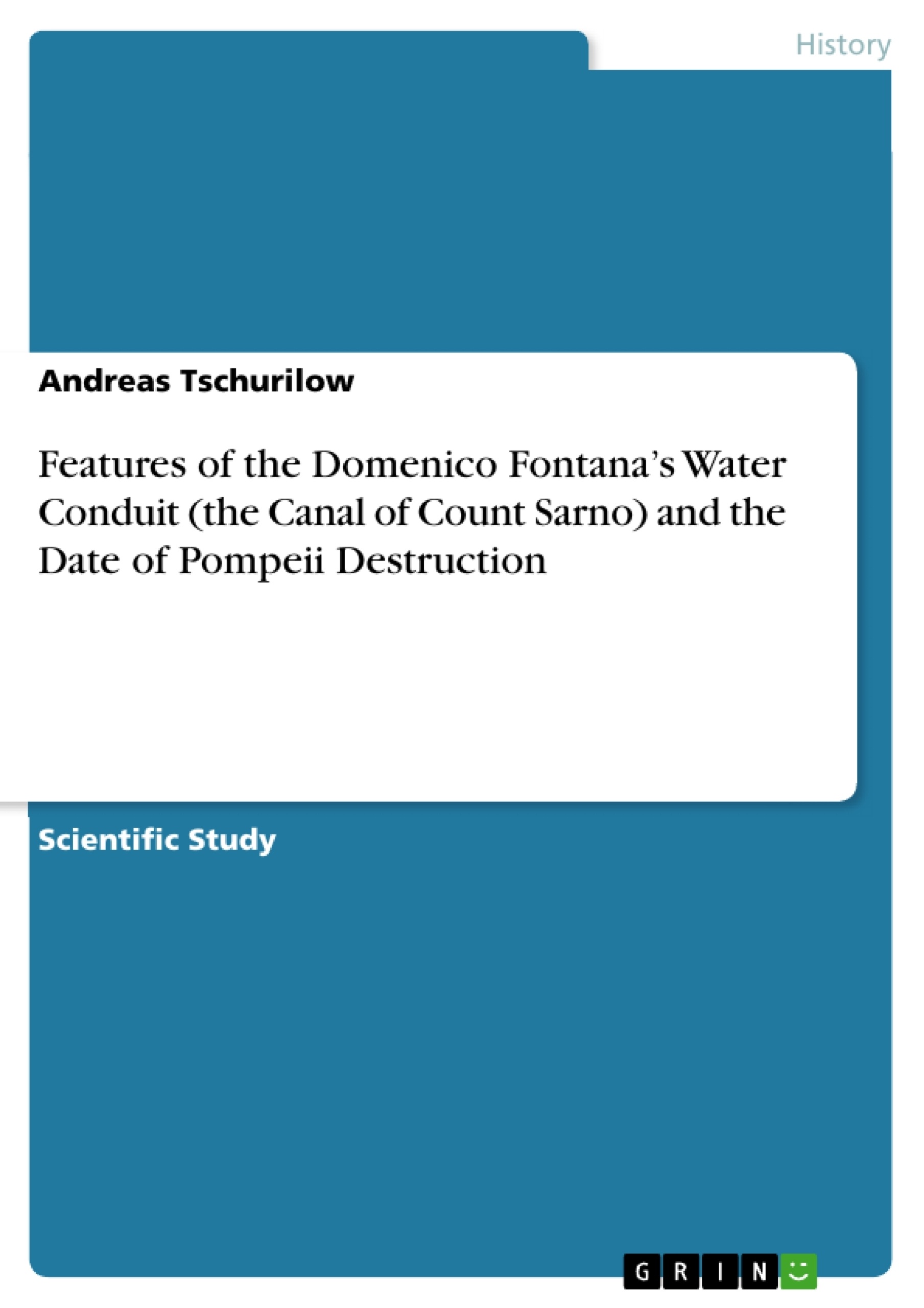It is considered that Pompeii was destroyed in the first century and, being buried under a layer of volcanic ash and pumice-stone, it remained forgotten for more than 1500 years until in 1592 the architect Domenico Fontana, during the construction of a canal to bring water to Torre Annunziata, found in an underground passageway several inscriptions on marble plates indicating the location of an ancient city. In this paper we present arguments in favor of another hypothesis: that Pompeii came to the end of its existence after the completion of the canal which was constructed in ruined city, however, still not fully covered by the volcanic ashes. The paper brings up for discussion some results of the author’s study partially popularized on the Internet and presents his opinion that the famous Pompeii, being excavated by the archeologists in the last 200 years, in fact finally disappeared off the face of the earth as a result of the eruption of Vesuvius in 1631.
Inhaltsverzeichnis (Table of Contents)
- Abstract
- Introduction
- Brief History of the Discovery of Pompeii
Zielsetzung und Themenschwerpunkte (Objectives and Key Themes)
The main objective of this paper is to challenge the established date of Pompeii's destruction, proposing a later date based on evidence related to Domenico Fontana's water conduit and the 1631 Vesuvius eruption. The author aims to present arguments supporting the hypothesis that Pompeii's final demise occurred after the canal's construction and the subsequent eruption.
- The date of Pompeii's destruction
- The role of Domenico Fontana's water conduit
- Evidence from historical sources and artifacts
- The impact of the 1631 Vesuvius eruption
- Technical challenges of constructing the water conduit through volcanic terrain
Zusammenfassung der Kapitel (Chapter Summaries)
Abstract: This abstract introduces the prevailing belief that Pompeii was destroyed in the first century AD and remained buried until its rediscovery in 1592. It then presents the author's alternative hypothesis: Pompeii's end came after the completion of Domenico Fontana's water conduit, with the city not yet fully buried by volcanic ash. The paper discusses the author's research, suggesting Pompeii's final destruction occurred during the 1631 Vesuvius eruption.
Introduction: The introduction acknowledges historical records of Vesuvius eruptions between 202 AD and 1140 AD. However, it highlights the lack of credible evidence for eruptions in the following 500 years until the catastrophic 1631 eruption. This eruption's devastation is detailed, including its impact on the surrounding population and the subsequent continuous activity of Vesuvius until 1944. The section introduces an epitaph commemorating the 1631 victims, notably listing Pompeii and Herculaneum among the affected cities, contradicting the traditional date of their destruction.
Brief History of the Discovery of Pompeii: This chapter discusses the accidental discoveries of Pompeii and Herculaneum. It details the role of Rocco Joaquin de Alcubierre in uncovering evidence of a buried city while restoring a water conduit, highlighting the significance of the hill's name, "Cività" (the city). The chapter then focuses on Domenico Fontana, the architect who constructed the water conduit that passed under Pompeii in the late 16th century, positing him as an earlier, albeit less recognized, discoverer of the buried city. The chapter also explores the conduit's history and its eventual repurposing for irrigation.
Schlüsselwörter (Keywords)
Pompeii, Vesuvius eruption, Domenico Fontana, 1631 eruption, water conduit, dating of Pompeii's destruction, historical sources, archaeological evidence, volcanic gases (mofette).
Frequently Asked Questions: A Re-Examination of Pompeii's Destruction Date
What is the main argument presented in this paper?
The paper challenges the traditional belief that Pompeii was destroyed in 79 AD. It proposes a later date for Pompeii's destruction, suggesting it occurred after the construction of Domenico Fontana's water conduit and during the devastating 1631 Vesuvius eruption.
What evidence is used to support the alternative hypothesis?
The paper uses multiple lines of evidence: the existence and construction of Domenico Fontana's water conduit passing under Pompeii in the late 16th century; an epitaph commemorating victims of the 1631 eruption, explicitly mentioning Pompeii and Herculaneum; and a reassessment of historical records concerning Vesuvius eruptions, highlighting the lack of substantial evidence for major eruptions between 1140 AD and 1631 AD.
Who was Domenico Fontana, and what is his connection to Pompeii?
Domenico Fontana was an architect who constructed a water conduit that passed beneath Pompeii in the late 16th century. The paper argues that his work inadvertently led to the rediscovery of the buried city, making him an earlier, albeit less recognized, discoverer of Pompeii. The conduit's construction and subsequent repurposing are central to the argument concerning the later date of Pompeii's destruction.
What role does the 1631 Vesuvius eruption play in this argument?
The 1631 Vesuvius eruption is presented as the likely cause of Pompeii's final destruction. The paper details the catastrophic scale of this eruption, its impact on the surrounding areas including Pompeii and Herculaneum, and its implications for the dating of Pompeii's destruction.
What are the key themes explored in the paper?
Key themes include the re-dating of Pompeii's destruction, the significance of Domenico Fontana's water conduit, the analysis of historical records and archeological evidence, the impact of the 1631 Vesuvius eruption, and the technical challenges of constructing the water conduit through volcanic terrain.
What are the chapter summaries provided?
The provided summaries cover the abstract introducing the argument, the introduction contextualizing the Vesuvius eruptions and highlighting the 1631 eruption, and a chapter focusing on the history of Pompeii's discovery, highlighting the roles of Rocco Joaquin de Alcubierre and Domenico Fontana.
What are the key words associated with this research?
The key words are: Pompeii, Vesuvius eruption, Domenico Fontana, 1631 eruption, water conduit, dating of Pompeii's destruction, historical sources, archaeological evidence, and volcanic gases (mofette).
- Quote paper
- Dipl. - Ing. (TU) Andreas Tschurilow (Author), 2009, Features of the Domenico Fontana’s Water Conduit (the Canal of Count Sarno) and the Date of Pompeii Destruction, Munich, GRIN Verlag, https://www.grin.com/document/140558



